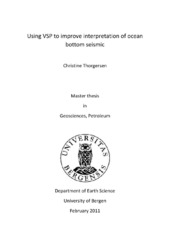| dc.description.abstract | Operating companies work continuously on increasing their knowledge about the reservoir. In mature areas of the North Sea many wells have been drilled, which can be used to obtain improved images of the subsurface in the area. 3D- and time-lapse (4D) techniques have evolved making it possible to monitor the production to a large degree. Likewise, seismic data processing methodologies and processing flows have been designed utilizing the seismic data to a high degree. However, yet much knowledge is to desire, and traditional methods only partially succeed. Therefore, additional methods must come in place. One such method is the use of converted (S) energy in seismic exploration. Anticipating the same source and similar attenuation mechanism for both P- and S-waves, the resolution of S-wave images should be superior to that of P-waves. Therefore, complementary information about the subsurface formations may be obtained by the careful analysis of Swaves. Due to multi-component seabed acquisition it is now possible to record and process converted (S) waves also in marine environments. One major drawback however is the poor quality of the converted energy of such data. It is often difficult to correlate the S-events to the P-events. This study is an attempt to increase the confidence of correlation between an S-event and the corresponding P-event on the multi-component data. To accomplish this task we make use of information from VSP. VSP (Vertical Seismic Profiling) is a seismic survey method whereby the receivers are positioned downhole in the wellbore, while the source is located on the surface. VSP has several advantages. By placing receivers in wells, closer to the structures we aim to map, we can improve the imaging of formations where the surface seismic fails to achieve interpretable results. It is also possible to construct seismic image of reflectors which extend laterally away from the borehole. In VSP we record both P- and converted (S)-waves. Beneficial to our purpose, the interpretation of the VSP will give information about mode-conversion taking place in the subsurface. We are able to tell whether the conversion has taken place as a reflected or a transmitted conversion (up or down), we may identify the formation tops acting as converting interfaces, and we may compute the formation interval S-wave velocity with confidence. A depth-velocity model incorporating VSP survey geometry, performed over the Snorre field, was built for both P- and S-waves. The models show the basic geometry of the VSP survey, and the raypaths, and the S-wave model also shows the mode conversion. The VSP data is compared to a 3D multi-component seabed seismic survey in the same area. The interpreted horizons in the 3D volume correlate well with the interpreted horizons of the VSP seismic profile. It is therefore shown that the use of both P- and S-waves from the VSP data can be used to correlate the interpretation of the converted (S) 3D volume to the regular P-wave 3D volume, and in addition provide new constraints on lithology (sand/shale ratio). | en_US |
